What am I to do with all this water?
Pumps for sea kayaks
This is absurd!
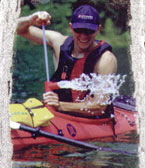
It’s also, perhaps more to the point, developing a false sense of security. (And it comes from the advertising of a well-known kayak manufacturer.)
(As well, it’s a poor example of dressing for sea kayaking: he’s setting up either for hypothermia or sunburn.)
What’s the problem?
Simply that in a real situation, after a real capsize in rough conditions, you will want both hands on the paddle to control the boat, and perhaps move away from a hazardous situation. You cannot allow yourself to be at the mercy of wind and wave while you fiddle with hand pumps, paddle floats and other junk.
Relying on a hand pump, especially one stowed on deck where, if it isn’t washed away will only get in the way, is to risk being unable to use it when you most need it. That hand pump is the wrong solution to the deficiencies of fundamentally flawed cockpit design.
What’s the answer?
There are, in fact, several, but all follow one simple rule: paddle the kayak. Whatever else is going on, you need to be able to paddle, and have your boat under control. That means that your pump must be capable of ‘no hands’ operation.
(This general principle is true in other fields too. In aviation, for instance, there’s the ‘fly the aircraft’ rule and the HOTAS (hands on throttle and stick) principle. When things get interesting you haven’t time to go poking about for this or that. (And yes, I do speak from experience; I held a PPL for some years.))
One popular option is an electric pump. When it’s needed, just switch it on. Very effective, and you can concentrate on what you should be doing, paddling.
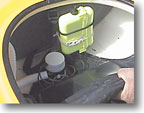
The usual pump is a marine bilge pump such as the Rule 500 and a separate power supply, with a switch on deck. The example shown is mounted behind the seat and has video camera NiCad batteries in a waterproof box. The switch is operated by pushing down on the spraycover.
Two problems. One is making sure that the battery is up to the task, fully charged. The other is resisting corrosion. Remember that you are trying to maintain an electrical system in salt water.
The other option is a foot pump. Effective, and with virtually no maintenance problems. In my view, the more reliable option, and reliability at sea is vital.
I first used a converted Chimp hand pump: converted because the pump is the kind that used to be mounted, until people realised that they were unworkable when needed most, on deck aft of the cockpit.
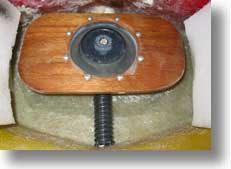
This one is in my own Nordkapp (built in 1978 and refitted several times), where the footrest is a ply plate on top of the pump. Intake hose is just 9 cm long, and outlet is through a short length of GRP paddle shaft glassed to the deck, and sealed with silicone. (Note the buoyancy material along the sides of the cockpit, retained by studs with discs on the ends.)
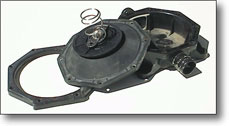
The procedure is to remove the handle and its lugs and fit a block standup spring inside. It can then be mounted on the forward bulkhead and the plumbing organised. Some people shorten the handle and leave it in place, using a length of shock cord instead of the internal spring: which system you use may depend on how much room you have in the cockpit.
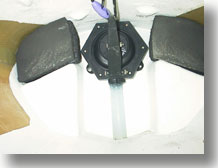
This is a neat installation, in a Nadgee, on a shaped bulkhead. There’s no outlet hose, and only a short inlet. In this case, the shortened handle is in place, with shock cord. (This pump is seen in action below.)
Cheaper, Asian made, pumps are also available (67546 in the Whitworths catalogue), and I am now using them. (But see ‘Diaphragm failures’ below.)
A few other points
You might also think about how much water you have to pump. Most kayak cockpits hold far too much water: reduce the cockpit volume and you reduce the amount that has to be pumped. You also make the boat easier to control by reducing free surface effects, and you must be able to paddle your kayak comfortably with the cockpit swamped. (Can you do that with yours? Try it.) Bulkheads should be as close as possible. Some builders fit side bulkheads as well. In an existing boat, put buoyancy material along the sides of the cockpit, like the one in the picture above, which also has buoyancy material beneath the seat. The only thing that needs to be in the cockpit is you. Leave no space for anything else.
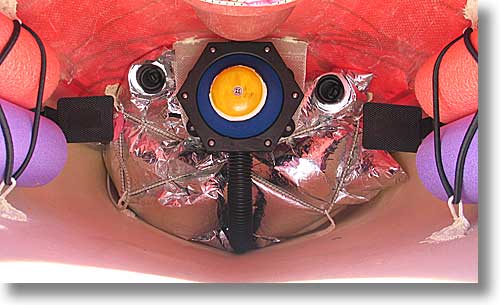
This is the foot pump in a Valley Etain, on a plate fixed to the deck and braced to the deck/bulkhead join. Against the bulkhead are airbags, and along the sides are lengths of pool noodle to reduce the cockpit volume. On expedition they’re replaced by equipment bags.
I would contend that some kayak manufacturers are leaving themselves open to litigation on this point. Look at accident reports and you find the same story over and over: swamped boats that could not be controlled. That’s the fundamental design flaw.
There are no Australian Design Rules for sea kayaks, but the old Sea Kayak Skills requirements for the Australian Canoeing Award Scheme (now Paddle Australia Qualification Scheme) were clear on this point:
‘a) kayak... with:
- minimum volume cockpit (bulkheads or integrated cockpit);...
- pump or self bailer capable of ‘no hands’ operation, with sponge as backup;...’)
Some people argue that hand pumps or deck mounted pumps with long hoses can be used to pump out flooded compartments. They have a point. I once had to do this near Cape du Couedic on the south western part of Kangaroo Island because he hadn’t sealed his forward hatch properly—made for an interesting day. There is justification for a hand pump in the group for just such contingencies, but it must not be regarded as anyone’s main pump. (Again from aviation: check things thoroughly, then check them again. That reduces the likelihood of surprises considerably.)
The bottom line
Everything must work as a coherent system, not as a collection of odd pieces. Simply adding a hand pump does not make for a safe kayak. When the going gets rough you must be able to concentrate on paddling: that means you need a minimum volume cockpit that you can handle swamped, and a hands free pump system. Nothing else is good (safe) enough.
You may also care to look at Over... and Still Out?, a critical look at sea kayak rescues.
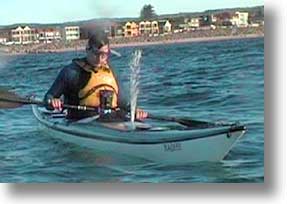
A foot pump in action: Phil Doddridge in a Nadgee. An interesting contrast with the picture at the top of the page. (From a video frame, taken during late afternoon rolling practice.)
Sea Kayaker February 2003
The February 2003 issue of Sea Kayaker had an item ‘Foot-powered Bilge Pump’ by Tom Finn. Finn correctly summarised the reasons for using foot pumps—hands-free operation, and lack of the maintenance required by electric systems—but his system is unnecessarily complex.
In part that is because the pump he uses has inlet and outlet together, but he has the inlet all the way to the aft end of the cockpit, with supporting brackets, strum box, etc.
Keep in mind a comment by French aircraft designer Antoine de Saint-Exupéry, who wrote “A designer knows he has achieved perfection not when there is nothing left to add, but when there is nothing left to take away.”
Sea Kayaker August 2003
The August 2003 issue of Kayaker had an account of a Tasmanian circumnavigation: ‘Way Down Under’. As the group attempted to pass Cape Portland one paddler capsized. Description of the event includes this:
‘Meanwhile Jenny... had swum her boat alongside mine, and I supported it as she climbed back in. Her cockpit was full of water, making the boat too unstable to paddle. We started to empty it with a handheld pump, but a spilling wave crashed across us and filled it to the brim. This approach wasn’t going to work, so I called to Daniel for help... Daniel attached a rope to her kayak and started to tow us off the rocks...’
So much easier with a boat that can be paddled when flooded, and emptied with a hands-free pump.
Diaphragm failures
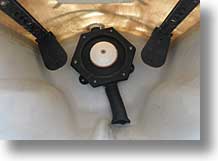
I had heard of the diaphragms in the Taiwanese pumps failing, and have had several of them split. I bought replacement diaphragms for two of them (now $18.95 each), but I’m now cutting replacements from an old wetsuit: note the blue diaphragm in the Etain pic above. Given that the wetsuit is over 30 years old, I think they’ll be more durable, certainly cheaper. Pic shows one of the pumps in a Platypus 5.